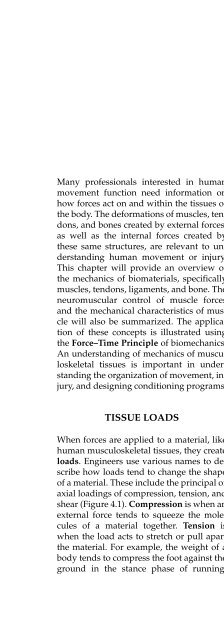Fundamentals of Biomechanics
Fundamentals of Biomechanics
Fundamentals of Biomechanics
You also want an ePaper? Increase the reach of your titles
YUMPU automatically turns print PDFs into web optimized ePapers that Google loves.
Many pr<strong>of</strong>essionals interested in human<br />
movement function need information on<br />
how forces act on and within the tissues <strong>of</strong><br />
the body. The deformations <strong>of</strong> muscles, tendons,<br />
and bones created by external forces,<br />
as well as the internal forces created by<br />
these same structures, are relevant to understanding<br />
human movement or injury.<br />
This chapter will provide an overview <strong>of</strong><br />
the mechanics <strong>of</strong> biomaterials, specifically<br />
muscles, tendons, ligaments, and bone. The<br />
neuromuscular control <strong>of</strong> muscle forces<br />
and the mechanical characteristics <strong>of</strong> muscle<br />
will also be summarized. The application<br />
<strong>of</strong> these concepts is illustrated using<br />
the Force–Time Principle <strong>of</strong> biomechanics.<br />
An understanding <strong>of</strong> mechanics <strong>of</strong> musculoskeletal<br />
tissues is important in understanding<br />
the organization <strong>of</strong> movement, injury,<br />
and designing conditioning programs.<br />
TISSUE LOADS<br />
When forces are applied to a material, like<br />
human musculoskeletal tissues, they create<br />
loads. Engineers use various names to describe<br />
how loads tend to change the shape<br />
<strong>of</strong> a material. These include the principal or<br />
axial loadings <strong>of</strong> compression, tension, and<br />
shear (Figure 4.1). Compression is when an<br />
external force tends to squeeze the molecules<br />
<strong>of</strong> a material together. Tension is<br />
when the load acts to stretch or pull apart<br />
the material. For example, the weight <strong>of</strong> a<br />
body tends to compress the foot against the<br />
ground in the stance phase <strong>of</strong> running,<br />
69<br />
which is resisted by tensile loading <strong>of</strong> the<br />
plantar fascia and the longitudinal ligament<br />
in the foot. Shear is a right-angle<br />
loading acting in opposite directions. A<br />
trainer creates a shearing load across athletic<br />
tape with scissor blades or their fingers<br />
when they tear the tape. Note that loads are<br />
not vectors (individual forces) acting in one<br />
direction, but are illustrated by two arrows<br />
(Figure 4.1) to show that the load results<br />
from forces from both directions.<br />
When many forces are acting on a body<br />
they can combine to create combined loads<br />
called torsion and bending (Figure 4.2). In<br />
bending one side <strong>of</strong> the material is loaded<br />
in compression while the other side experiences<br />
tensile loading. When a person is in<br />
single support in walking (essentially a<br />
one-legged chair), the femur experiences<br />
bending loading. The medial aspect <strong>of</strong> the<br />
femur is in compression while the lateral<br />
aspect is in tension.<br />
RESPONSE OF TISSUES<br />
TO FORCES<br />
CHAPTER 4<br />
Mechanics <strong>of</strong> the<br />
Musculoskeletal System<br />
The immediate response <strong>of</strong> tissues to loading<br />
depends on a variety <strong>of</strong> factors. The<br />
size and direction <strong>of</strong> forces, as well as<br />
the mechanical strength and shape <strong>of</strong><br />
the tissue, affect how the material structure<br />
will change. We will see in this section<br />
that mechanical strength and muscular<br />
strength are different concepts. This text<br />
will strive to use “muscular” or “mechanical”<br />
modifiers with the term strength to






